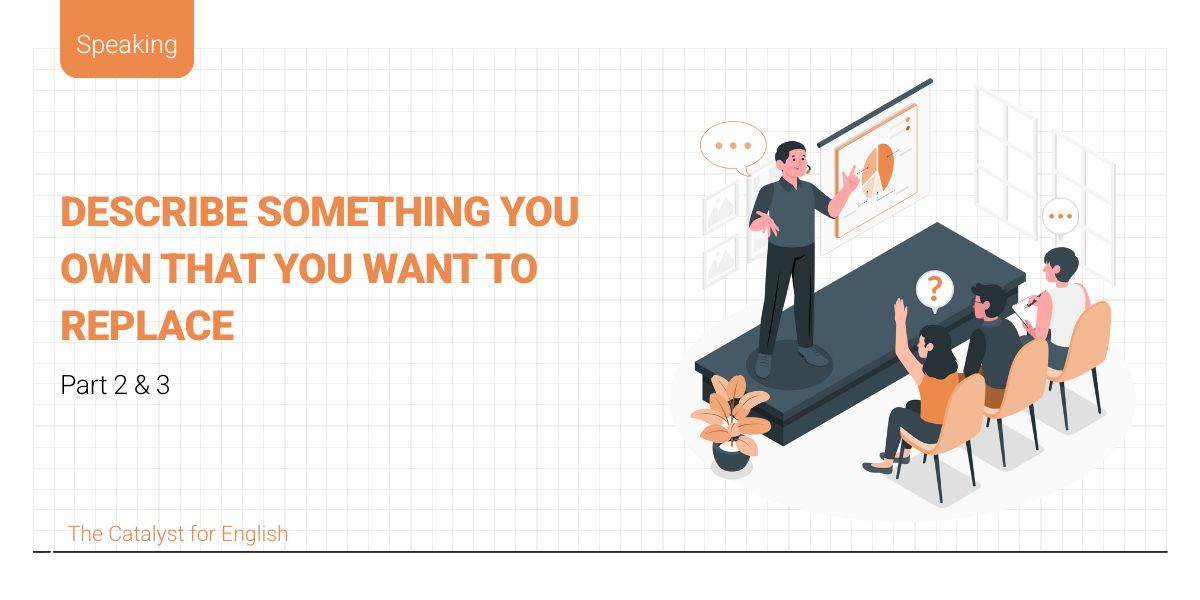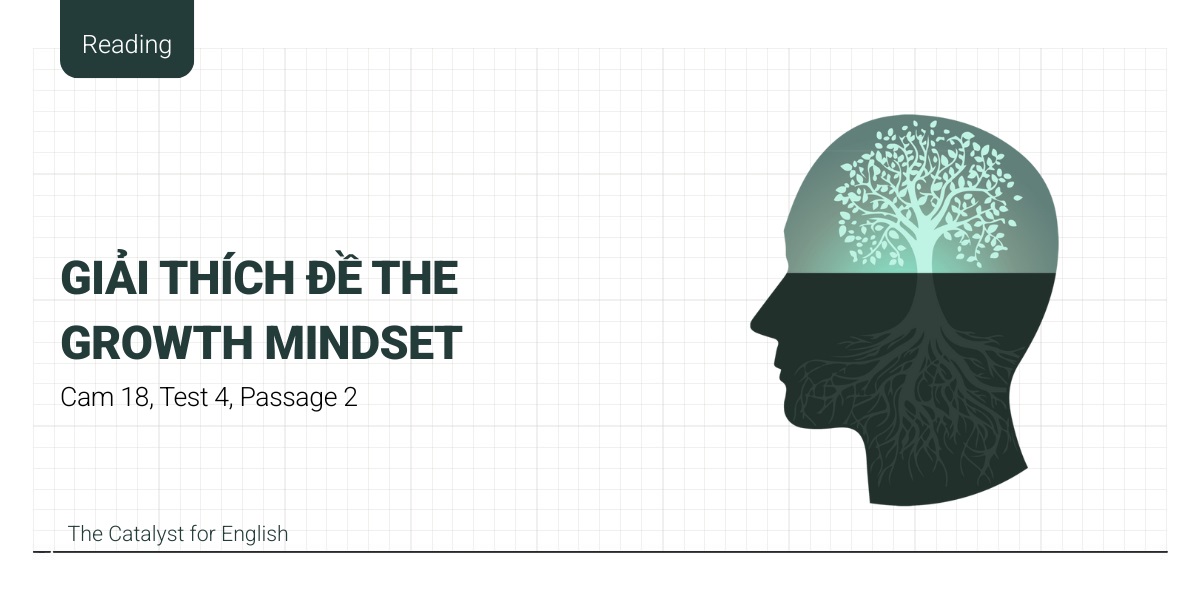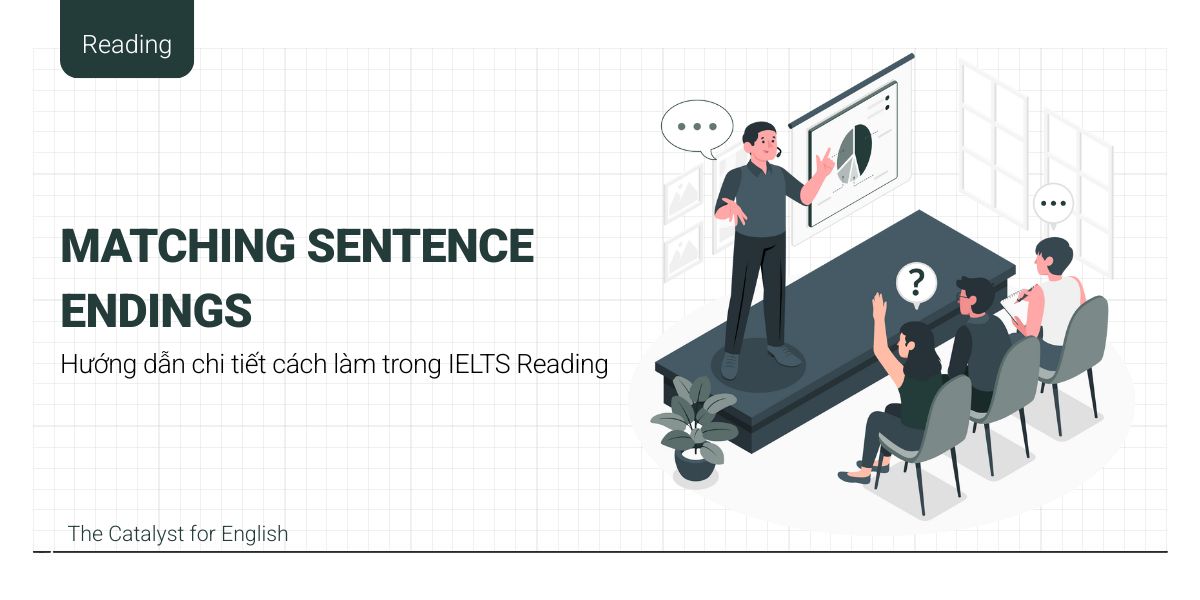Để chinh phục phần thi Reading, bên cạnh vốn từ vựng phong phú, bạn còn cần thành thạo chiến thuật xử lý từng dạng câu hỏi. Hôm nay, The Catalyst for English (TCE) sẽ đồng hành cùng bạn phân tích chi tiết bài đọc “The growth mindset” (Cam 18 – Test 4, Passage 2) và gợi ý cách tránh lỗi hiệu quả. Cùng chúng mình khám phá ngay bí quyết làm bài và nâng band IELTS Reading của mình nhé!
I. Đề bài IELTS Reading “The growth mindset”
The growth mindset
Over the past century, a powerful idea has taken root in the educational landscape. The concept of intelligence as something innate has been supplanted by the idea that intelligence is not fixed, and that, with the right training, we can be the authors of our own cognitive capabilities. Psychologist Alfred Binet, the developer of the first intelligence tests, was one of many 19th-century scientists who held that earlier view and sought to quantify cognitive ability. Then, in the early 20th century, progressive thinkers revolted against the notion that inherent ability is destiny. Instead, educators such as John Dewey argued that every child’s intelligence could be developed, given the right environment.
‘Growth mindset theory’ is a relatively new — and extremely popular — version of this idea. In many schools today you will see hallways covered in motivational posters and hear speeches on the mindset of great sporting heroes who simply believed their way to the top. A major focus of the growth mindset in schools is coaxing students away from seeing failure as an indication of their ability, and towards seeing it as a chance to improve that ability. As educationalist Jeff Howard noted several decades ago: ‘Smart is not something that you just are, smart is something that you can get.’
The idea of the growth mindset is based on the work of psychologist Carol Dweek in California in the 1990s. In one key experiment, Dweck divided a group of 10- to 12-year-olds into two groups. All were told that they had achieved a high score on a test but the first group were praised for their intelligence in achieving this, while the others were praised for their effort. The second group — those who had been instilled with a ‘growth mindset’ — were subsequently far more likely to put effort into future tasks. Meanwhile, the former took on only those tasks that would not risk their sense of worth. This group had inferred that success or failure is due to innate ability, and this ‘fixed mindset’ had led them to fear of failure and lack of effort. Praising ability actually made the students perform worse, while praising effort emphasised that change was possible.
One of the greatest impediments to successfully implementing a growth mindset, however, is the education system itself: in many parts of the world, the school climate is obsessed with performance in the form of constant testing, analysing and ranking of students — a key characteristic of the fixed mindset. Nor is it unusual for schools to create a certain cognitive dissonance, when they applaud the benefits of a growth mindset but then hand out fixed target grades in lessons based on performance.
Aside from the implementation problem, the original growth mindset research has also received harsh criticism. The statistician Andrew Gelman claims that ‘their research designs have enough degrees of freedom that they could take their data to support just about any theory at all’. Professor of Psychology Timothy Bates, who has been trying to replicate Dweck’s work, is finding that the results are repeatedly null. He notes that: ‘People with a growth mindset don’t cope any better with failure … Kids with the growth mindset aren’t getting better grades, either before or after our intervention study.’
Much of this criticism is not lost on Dweck, and she deserves great credit for responding to it and adapting her work accordingly. In fact, she argues that her work has been misunderstood and misapplied in a range of ways. She has also expressed concerns that her theories are being misappropriated in schools by being conflated with the self-esteem movement: ‘For me the growth mindset is a tool for learning and improvement. It’s not just a vehicle for making children feel good.’
But there is another factor at work here. The failure to translate the growth mindset into the classroom might reflect a misunderstanding of the nature of teaching and learning itself. Growth mindset supporters David Yeager and Gregory Walton claim that interventions should be delivered in a subtle way to maximise their effectiveness. They say that if adolescents perceive a teacher’s intervention as conveying that they are in need of help, this could undo its intended effects.
A lot of what drives students is their innate beliefs and how they perceive themselves. There is a strong correlation between self-perception and achievement, but there is evidence to suggest that the actual effect of achievement on self-perception is stronger than the other way round. To stand up in a classroom and successfully deliver a good speech is a genuine achievement, and that is likely to be more powerfully motivating than vague notions of ‘motivation’ itself.
Recent evidence would suggest that growth mindset interventions are not the elixir of student learning that its proponents claim it to be. The growth mindset appears to be a viable construct in the lab, which, when administered in the classroom via targeted interventions, doesn’t seem to work. It is hard to dispute that having faith in the capacity to change is a good attribute for students. Paradoxically, however, that aspiration is not well served by direct interventions that try to instil it.
Motivational posters and talks are often a waste of time, and might well give students a deluded notion of what success actually means. Teaching concrete skills such as how to write an effective introduction to an essay then praising students’ effort in getting there is probably a far better way of improving confidence than telling them how unique they are, or indeed how capable they are of changing their own brains. Perhaps growth mindset works best as a philosophy and not an intervention.
Questions 14-16
Choose the correct letter, A, B, C or D.
Write the correct letter in boxes 14-16 on your answer sheet
14 What can we learn from the first paragraph?
A where the notion of innate intelligence first began
B when ideas about the nature of intelligence began to shift
C how scientists have responded to changing views of intelligence
D why thinkers turned away from the idea of intelligence being fixed
15 The second paragraph describes how schools encourage students to
A identify their personal ambitions.
B help each other to realise their goals.
C have confidence in their potential to succeed.
D concentrate on where their particular strengths lie.
16 In the third paragraph, the writer suggests that students with a fixed mindset
A tend to be less competitive.
B generally have a low sense of self-esteem.
C will only work hard if they are given constant encouragement.
D are afraid to push themselves beyond what they see as their limitations
Questions 17-22
Look at the following statements (Questions 17-22) and the list of people below.
Match each statement with the correct person or people, A-E.
Write the correct letter, A-E, in boxes 17-22 on your answer sheet.
NB You may use any letter more than once.
17 The methodology behind the growth mindset studies was not strict enough.
18 The idea of the growth mindset has been incorrectly interpreted.
19 Intellectual ability is an unchangeable feature of each individual.
20 The growth mindset should be promoted without students being aware of it.
21 The growth mindset is not simply about boosting students’ morale.
22 Research shows that the growth mindset has no effect on academic achievement.
List of People
- Alfred Binet
- Carol Dweck
- Andrew Gelman
- Timothy Bates
- David Yeager and Gregory Walton
Questions 23 – 26
Do the following statements agree with the views of the writer in Reading Passage 2?
In boxes 23—26 on your answer sheet, write
| YES |
if the statement agrees with the views of the writer |
| NO |
if the statement contradicts the views of the writer |
| NOT GIVEN |
if it is impossible to say what the writer thinks about this |
- Dweck has handled criticisms of her work in an admirable way.
- Students’ self-perception is a more effective driver of self-confidence than actual achievement is.
- Recent evidence about growth mindset interventions has attracted unfair coverage in the media.
- Deliberate attempts to encourage students to strive for high achievement may have a negative effect.
II. Đáp án chi tiết
| Question |
Answer |
| 14 |
B |
| 15 |
C |
| 16 |
D |
| 17 |
C |
| 18 |
B |
| 19 |
A |
| 20 |
E |
| 21 |
B |
| 22 |
D |
| 23 |
YES |
| 24 |
NO |
| 25 |
NOT GIVEN |
| 26 |
YES |
III. Giải thích đáp án chi tiết
Với mục đích giúp bạn hiểu các đáp án trong bài đọc “The growth mindset”, thầy Đức Nam – giảng viên 8.0 IELTS tại TCE – đã tổng hợp và phân tích chi tiết như sau:
| Questions 14 – 16: Dạng bài MCQ
Cách làm:
- Bước 1: Xem kỹ câu hỏi và kẻ dưới các từ khóa quan trọng.
- Bước 2: Dò tìm và xác định vị trí những từ khóa ấy trong đoạn văn.
- Bước 3: Nhận diện cách diễn đạt đồng nghĩa (paraphrase) giữa câu hỏi và văn bản.
- Bước 4: Chọn phương án phù hợp nhất, sau đó kiểm chứng lại bằng cách loại bỏ những đáp án còn lại.
|
Questions 14:
Đáp án: B
Giải thích chi tiết:
| Key trong câu hỏi |
Key trong bài |
Giải thích |
| What can we learn from the first paragraph?
A. where the notion of innate intelligence first began
B. when ideas about the nature of intelligence began to shift
C. how scientists have responded to changing views of intelligence
D. why thinker turned away from the idea of intelligence being fixed |
Over the past century, a powerful idea has taken root in the educational landscape. The concept of intelligence as something innate has been supplanted by the idea that intelligence is not fixed […] Then, in the early 20th century, progressive thinkers revolted against the notion that inherent ability is destiny. |
Trong suốt một thế kỷ qua, khái niệm về trí tuệ đã được thay đổi: thay vì coi nó là năng lực cố định bẩm sinh, người ta bắt đầu nhận thấy trí tuệ có thể thay đổi và phát triển. Vào đầu thế kỷ 20, những nhà tư tưởng tiến bộ đã phản bác quan điểm cho rằng số phận của mỗi người đã được định đoạt ngay từ khi sinh ra.
Phân tích các phương án trả lời:
- A: Nói về Alfred Binet và bài kiểm tra IQ đầu tiên, không đề cập nơi khởi nguồn của ý tưởng “trí tuệ bẩm sinh” ⇒ loại.
- B: Nhấn mạnh thời điểm tư tưởng về bản chất trí tuệ bắt đầu thay đổi ⇒ chọn.
- C: Không có thông tin về phản ứng của giới khoa học trước quan niệm mới ⇒ loại.
- D: Chỉ đề cập những người tiến bộ phản đối quan điểm số mệnh, nhưng không giải thích lý do ⇒ loại.
=> Đáp án: B |
Questions 15:
Đáp án: C
Giải thích chi tiết:
| Key trong câu hỏi |
Key trong bài |
Giải thích |
| The second paragraph describes how schools encourage students to
A. identify their personal ambitions
B. help each other to realise their goals
C. have confidence in their potential to succeed
D. concentrate on where their particular strengths lie |
In many schools today you will see hallways covered in motivational posters and hear speeches on the mindset of great sporting heroes who simply believed their way to the top. A major focus of the growth mindset in schools is coaxing students away from seeing failure as an indication of their ability, and towards seeing it as a chance to improve that ability. |
Ngày nay, nhiều trường học trang trí hành lang bằng những bảng thông điệp động viên và tổ chức các buổi nói chuyện truyền cảm hứng, nhấn mạnh rằng chỉ cần tin vào chính mình, ai cũng có thể chinh phục đỉnh cao. Trong tư duy phát triển, trường học khuyến khích học sinh không xem thất bại là dấu chấm hết cho năng lực, mà là cơ hội để rèn luyện và nâng cao kỹ năng.
Phân tích đáp án:
- A: Không có thông tin về tham vọng cá nhân ⇒ loại.
- B: Không nhắc đến việc học sinh giúp đỡ nhau nhận ra mục tiêu ⇒ loại.
- C: Đúng: đề cập đến áp phích động lực và bài diễn thuyết nhằm khích lệ học sinh tin vào tiềm năng để thành công ⇒ chọn.
- D: Không có nội dung về tập trung vào điểm mạnh ⇒ loại.
=> Đáp án: C |
Questions 16:
Đáp án: D
Giải thích chi tiết:
| Key trong câu hỏi |
Key trong bài |
Giải thích |
| In the third paragraph, the writer suggests that students with a fixed mindset
A. tend to be less competitive
B. generally have a low sense of self-esteem
C. will only work hard if they are given constant encouragement
D. are afraid to push themselves beyond what they see as their limitations |
Meanwhile, the former took on only those tasks that would not risk their sense of worth. This group had inferred that success or failure is due to innate ability, and this ‘fixed mindset’ had led them to fear of failure and lack of effort. |
Ngược lại, nhóm này chỉ chọn những nhiệm vụ “an toàn” để không đe dọa đến giá trị bản thân. Họ cho rằng thành công hay thất bại chủ yếu dựa vào năng lực bẩm sinh, chính tư duy cố định ấy đã khiến họ sợ thất bại và không dám nỗ lực.
Phân tích các đáp án:
- A: Chỉ đề cập đến nhiệm vụ dễ dàng, không nói học sinh có tư duy cố định ít cạnh tranh ⇒ loại.
- B: Nói họ sợ thất bại và không nỗ lực, không nhắc tới tự trọng thấp ⇒ loại.
- C: Đề cập khen ngợi sẽ khiến họ cố gắng hơn, trái ngược với nội dung ⇒ loại.
- D: Học sinh tư duy cố định lo ngại rủi ro nên chỉ chọn nhiệm vụ an toàn ⇒ chọn.
=> Đáp án đúng: D. |
| Questions 17 – 22: Dạng bài Matching Information
Cách làm:
- Bước 1: Xem qua danh sách tên riêng mà đề bài cung cấp.
- Bước 2: Tìm và đánh dấu vị trí mỗi tên riêng trong đoạn văn.
- Bước 3: Đọc lướt khoảng 2–3 dòng trên và dưới chỗ có tên riêng để nắm thông tin liên quan.
- Bước 4: Đối chiếu những thông tin vừa thu thập với danh sách dữ kiện trong đề, sau đó ghép nối cho phù hợp.
Lưu ý:
- Một số tên riêng có thể tương ứng với nhiều đáp án khác nhau.
|
Questions 17:
Đáp án: C
Giải thích chi tiết:
| Key trong câu hỏi |
Key trong bài |
Giải thích |
| The methodology behind the growth mindset studies was not strict enough. |
The statistician Andrew Gelman claims that ‘their research designs have enough degrees of freedom that they could take their data to support just about any theory at all’. |
Như nhà thống kê Andrew Gelman đã chỉ ra, các phương pháp thiết kế nghiên cứu thường linh hoạt đến mức cho phép người ta tận dụng dữ liệu để bảo vệ bất cứ giả thuyết nào họ mong muốn. |
Questions 18:
Đáp án: B
Giải thích chi tiết:
| Key trong câu hỏi |
Key trong bài |
Giải thích |
| The idea of the growth mindset has been incorrectly interpreted. |
Much of this criticism is not lost on Dweck […] In fact, she argues that her work has been misunderstood and misapplied in a range of ways. |
Dweck tỏ ra ngạc nhiên trước các chỉ trích này và thực sự xứng đáng được ghi nhận vì đã lắng nghe phản hồi cũng như điều chỉnh công trình của mình. Trên thực tế, cô cho rằng tác phẩm của mình thường xuyên bị hiểu nhầm và vận dụng sai lệch theo nhiều cách khác nhau. |
Questions 19:
Đáp án: A
Giải thích chi tiết:
| Key trong câu hỏi |
Key trong bài |
Giải thích |
| Intellectual ability is an unchangeable feature of each individual. |
The concept of intelligence as something innate has been supplanted by the idea that intelligence is not fixed […] Psychologist Alfred Binet, the developer of the first intelligence tests, was one of many 19th-century scientists who held that earlier view and sought to quantify cognitive ability. |
Alfred Binet – nhà tâm lý học người đã tạo ra những bài kiểm tra thông minh đầu tiên – là một trong số các nhà khoa học thế kỷ 19 theo đuổi quan điểm này và tìm cách đo lường năng lực nhận thức. |
Questions 20:
Đáp án: E
Giải thích chi tiết:
| Key trong câu hỏi |
Key trong bài |
Giải thích |
| The growth mindset should be promoted without students being aware of it. |
Growth mindset supporters David Yeager and Gregory Walton claim that interventions should be delivered in a subtle way to maximize their effectiveness. They say that if adolescents perceive a teacher’s intervention as conveying that they are in need of help, this could undo its intended effects. |
Theo David Yeager và Gregory Walton – những người theo đuổi quan điểm phát triển –, các biện pháp can thiệp cần được xây dựng và áp dụng một cách khéo léo nhằm phát huy tối đa hiệu quả của chúng.
=> Đáp án: E |
Questions 21:
Đáp án: B
Giải thích chi tiết:
| Key trong câu hỏi |
Key trong bài |
Giải thích |
| The growth mindset is not simply about boosting students’ morale. |
She has also expressed concerns that her theories are being misappropriated in schools by being conflated with the self-esteem movement: ‘For me the growth mindset is a tool for learning and improvement. It’s not just a vehicle for making children feel good. |
Cô cũng bày tỏ mối lo ngại rằng các lý thuyết của mình đang bị hiểu sai và lợi dụng trong nhà trường, khi người ta nhầm chúng với phong trào đề cao lòng tự trọng: “Với tôi, tư tưởng phát triển là công cụ để học hỏi và tiến bộ, chứ không chỉ đơn thuần là cách khiến trẻ em thấy tốt.”
=> Đáp án: B |
Questions 22:
Đáp án: D
Giải thích chi tiết:
| Key trong câu hỏi |
Key trong bài |
Giải thích |
| Research shows that the growth mindset has no effect on academic achievement. |
Professor of Psychology Timothy Bates, who has been trying to replicate Dweck’s work, is finding that the results are repeatedly null. He notes that: ‘People with a growth mindset don’t cope any better with failure … Kids with the growth mindset aren’t getting better grades, either before or after our intervention study. |
Giáo sư tâm lý học Timothy Bates, trong nỗ lực tái tạo các thí nghiệm của Dweck, nhận thấy rằng kết quả không nhất quán. Ông chỉ ra: “Những người mang tư duy phát triển không ứng xử tốt hơn khi đối mặt với thất bại… Trẻ em có tư duy phát triển cũng không cải thiện được điểm số, cả trước và sau can thiệp của chúng tôi.”
=> Đáp án: D |
| Questions 23-26: Dạng bài TRUE/FALSE/NOT GIVEN & YES/NO/NOT GIVEN
Cách làm:
- Bước 1: Đọc kỹ câu hỏi và đánh dấu những từ khóa chính.
- Bước 2: Quét (scan) văn bản để tìm những từ khóa đã đánh dấu.
- Bước 3: Chú ý đến các từ điều khiển (như not, only, the majority…).
- Bước 4: Lựa chọn đáp án tương ứng:
+ Nếu toàn bộ thông tin trong câu hỏi đều có trong đoạn văn: chọn TRUE/YES.
+ Nếu ít nhất một chi tiết trong câu hỏi mâu thuẫn với nội dung đoạn văn: chọn FALSE/NO.
+ Nếu không tìm thấy đủ nội dung hỏi (ví dụ: câu hỏi có ba yếu tố nhưng văn bản chỉ nhắc hai) hoặc hoàn toàn không có thông tin liên quan: chọn NOT GIVEN. |
Questions 23:
Đáp án: Yes
Giải thích chi tiết:
| Key trong câu hỏi |
Key trong bài |
Giải thích |
| Dweck has handled criticism of her work in an admirable way. |
Much of this criticism is not lost on Dweck, and she deserves great credit for responding to it and adapting her work accordingly. |
Câu hỏi khẳng định rằng Dweck đã đáp lại những lời chỉ trích về công trình của mình một cách đầy ấn tượng. Điều này hoàn toàn phù hợp với nội dung trong bài: “Dweck thấu hiểu các phản biện đó, cô xứng đáng nhận được sự công nhận lớn vì đã phản hồi và điều chỉnh công trình của mình dựa trên chúng.”
→ Đáp án: YES |
Questions 24:
Đáp án: No
Giải thích chi tiết:
| Key trong câu hỏi |
Key trong bài |
Giải thích |
| Students’ self-perception is a more effective driver of self-confidence than actual achievement. |
There is a strong correlation between self-perception and achievement, but there is evidence to suggest that the actual effect of achievement on self-perception is stronger than the other way round. To stand up in a classroom and successfully deliver a good speech is a genuine achievement, and that is likely to be more powerfully motivating than vague notions of ‘motivation’ itself. |
Câu hỏi cho rằng sự tự nhận thức của học sinh là yếu tố thúc đẩy sự tự tin hiệu quả hơn so với thành tích thực tế. Tuy nhiên, điều này mâu thuẫn với nội dung bài đọc: “Tuy có mối liên hệ rõ ràng giữa tự nhận thức và thành tích, nhưng bằng chứng cho thấy thành tích thực tế có ảnh hưởng mạnh hơn đến sự tự nhận thức. Ví dụ, việc đứng trước lớp và trình bày một bài thuyết trình thành công là một thành tựu thực sự và có khả năng tạo động lực lớn hơn nhiều so với những khái niệm trừu tượng về ‘động lực’.”
=> Đáp án: NO |
Questions 25:
Đáp án: NOT GIVEN
Giải thích chi tiết:
| Key trong câu hỏi |
Key trong bài |
Giải thích |
| Recent evidence about growth mindset interventions has attracted unfair coverage in the media. |
Recent evidence would suggest that growth mindset interventions are not the elixir of student learning that its proponents claim it to be. The growth mindset appears to be a viable construct in the lab, which, when administered in the classroom via targeted interventions, doesn’t seem to work. |
Bài đọc chỉ đề cập đến các bối cảnh như phòng thí nghiệm và lớp học, mà không hề nhắc đến việc liệu các phương tiện truyền thông có bị thu hút bởi những can thiệp liên quan đến tư tưởng phát triển hay không.
=> Đáp án: NOT GIVEN |
Questions 26:
Đáp án: Yes
Giải thích chi tiết:
| Key trong câu hỏi |
Key trong bài |
Giải thích |
| Deliberate attempts to encourage students to strive for high achievement may have a negative effect. |
There is a strong correlation between self-perception and achievement, but there is evidence to suggest that the actual effect of achievement on self-perception is stronger than the other way round.
[…]
It is hard to dispute that having faith in the capacity to change is a good attribute for students. Paradoxically, however, that aspiration is not well served by direct interventions that try to instill it. |
Câu hỏi cho rằng nỗ lực thúc đẩy học sinh đạt được thành tích có thể mang lại tác động tiêu cực. Điều này phù hợp với thông tin trong bài: mặc dù niềm tin vào khả năng phát triển là điều tích cực, nhưng việc cố gắng truyền đạt điều đó thông qua các can thiệp trực tiếp lại không mang lại hiệu quả như mong muốn, thậm chí có thể phản tác dụng.
=> Đáp án: YES |
Bên cạnh dạng bài MCQ, Matching Names, TRUE/FALSE/NOT GIVEN & YES/NO/NOT GIVEN của The growth mindset trên đây, bạn có thể luyện tập thêm các dạng đề Reading khác bằng cách tham gia Luyện tập miễn phí trên trang web của TCE. Tại đây chúng mình có đầy đủ các dạng đề Reading chuẩn thi thật cho các bạn thực hành.
Trên đây là phần đáp án kèm phân tích chi tiết cho bài đọc The growth mindset, được thực hiện bởi đội ngũ chuyên môn tại The Catalyst for English. Chúng mình hy vọng những thông tin này sẽ giúp bạn nâng cao hiệu quả ôn luyện kỹ năng đọc trong bài thi IELTS. Đừng quên truy cập chuyên mục IELTS Reading của TCE để khám phá thêm nhiều bài mẫu chất lượng khác nhé!




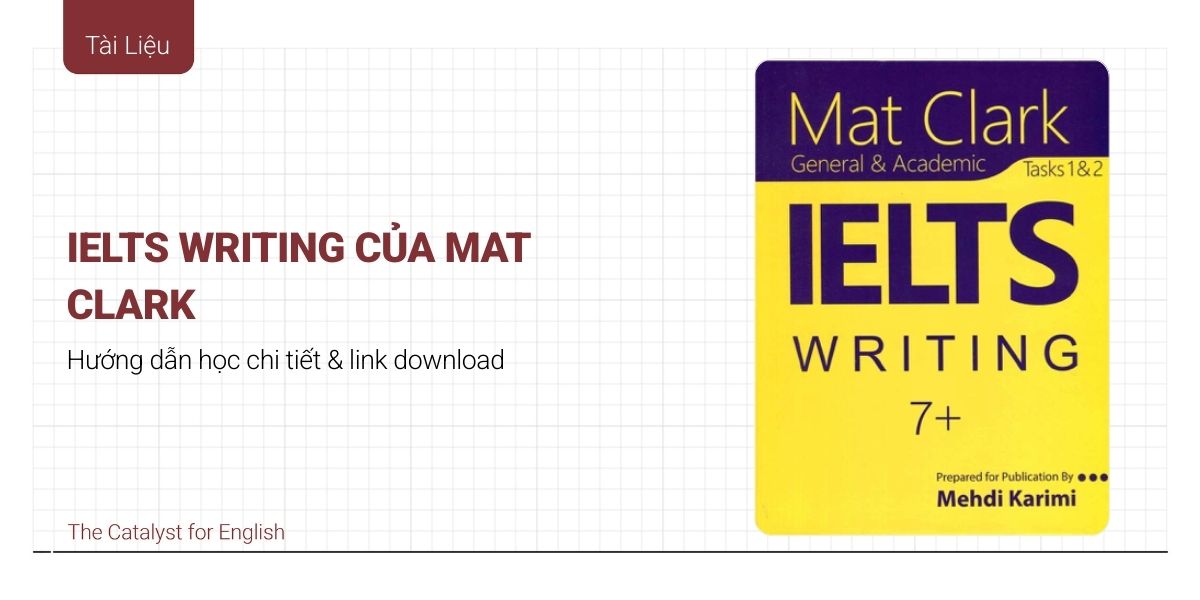

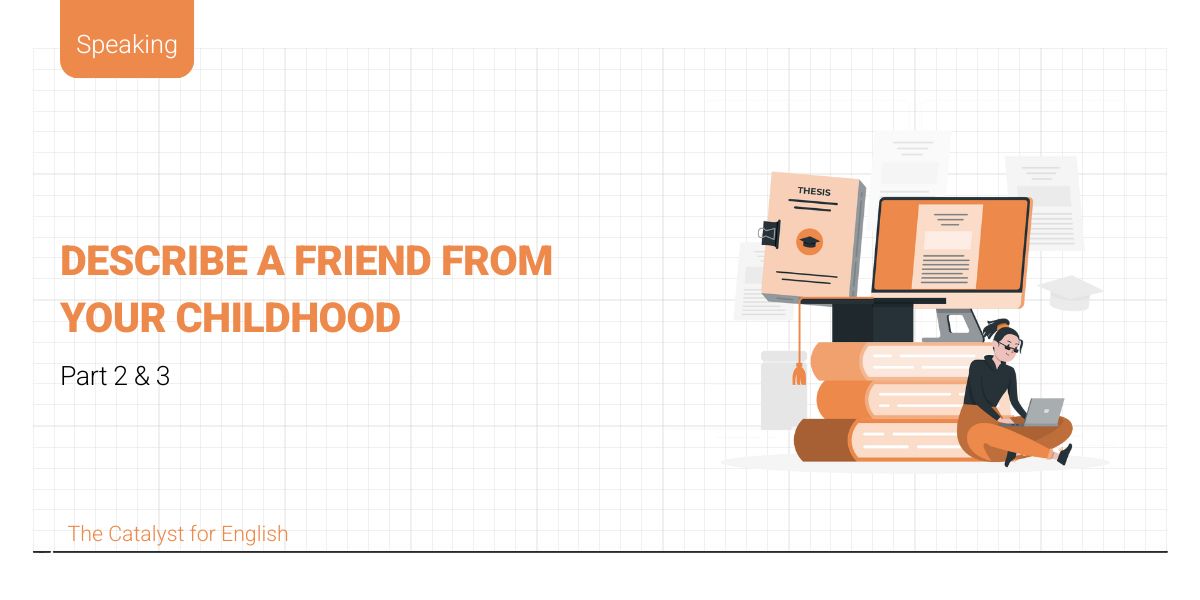
![[PDF] Review Understanding and Using English Grammar](https://thecatalyst.edu.vn/blogs/wp-content/uploads/2025/12/understanding-and-using-english-grammar.jpg)
